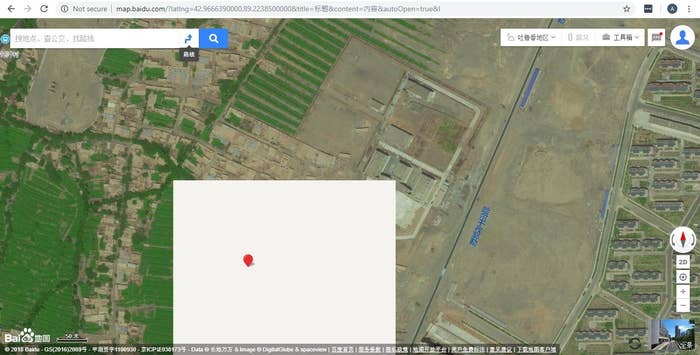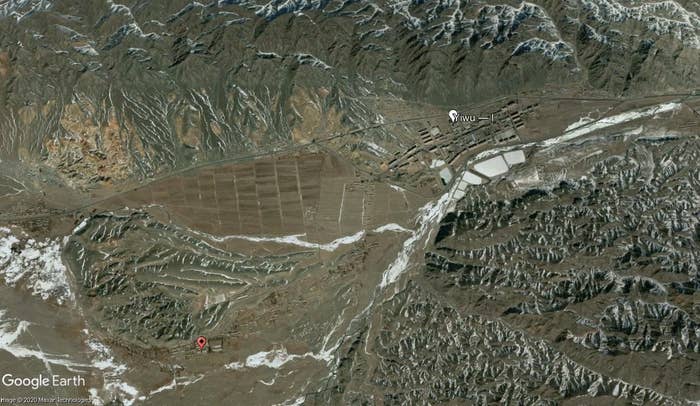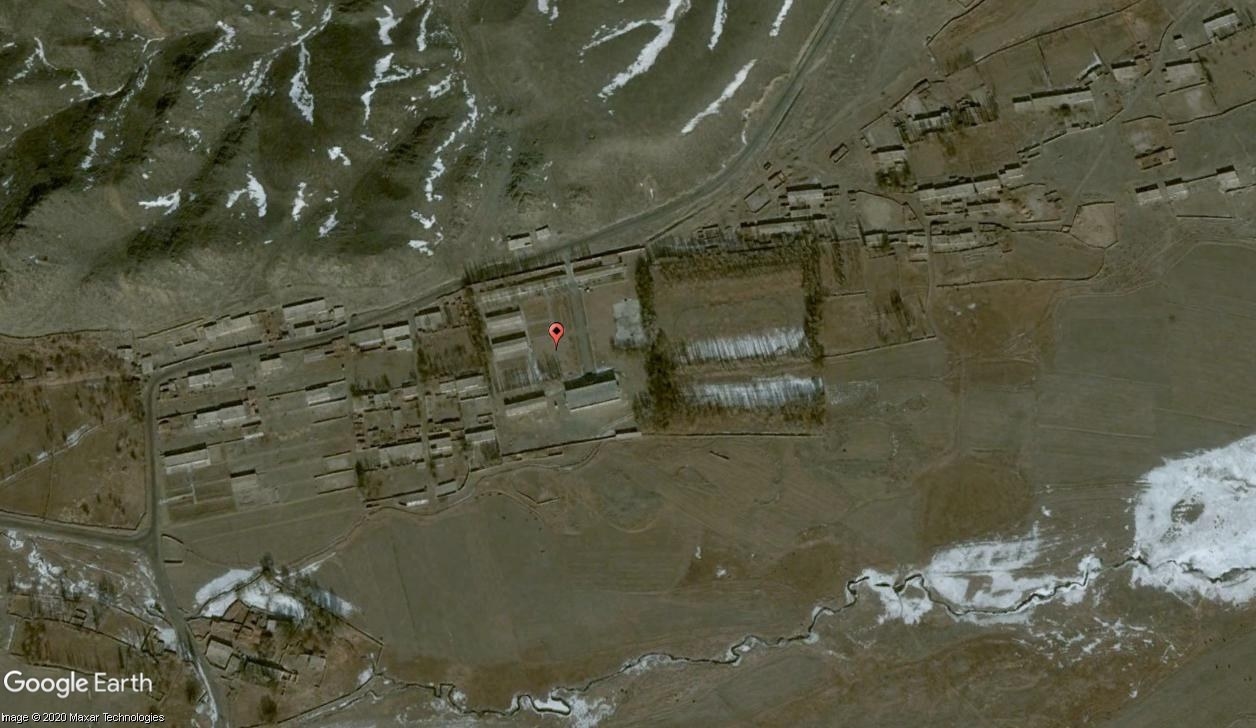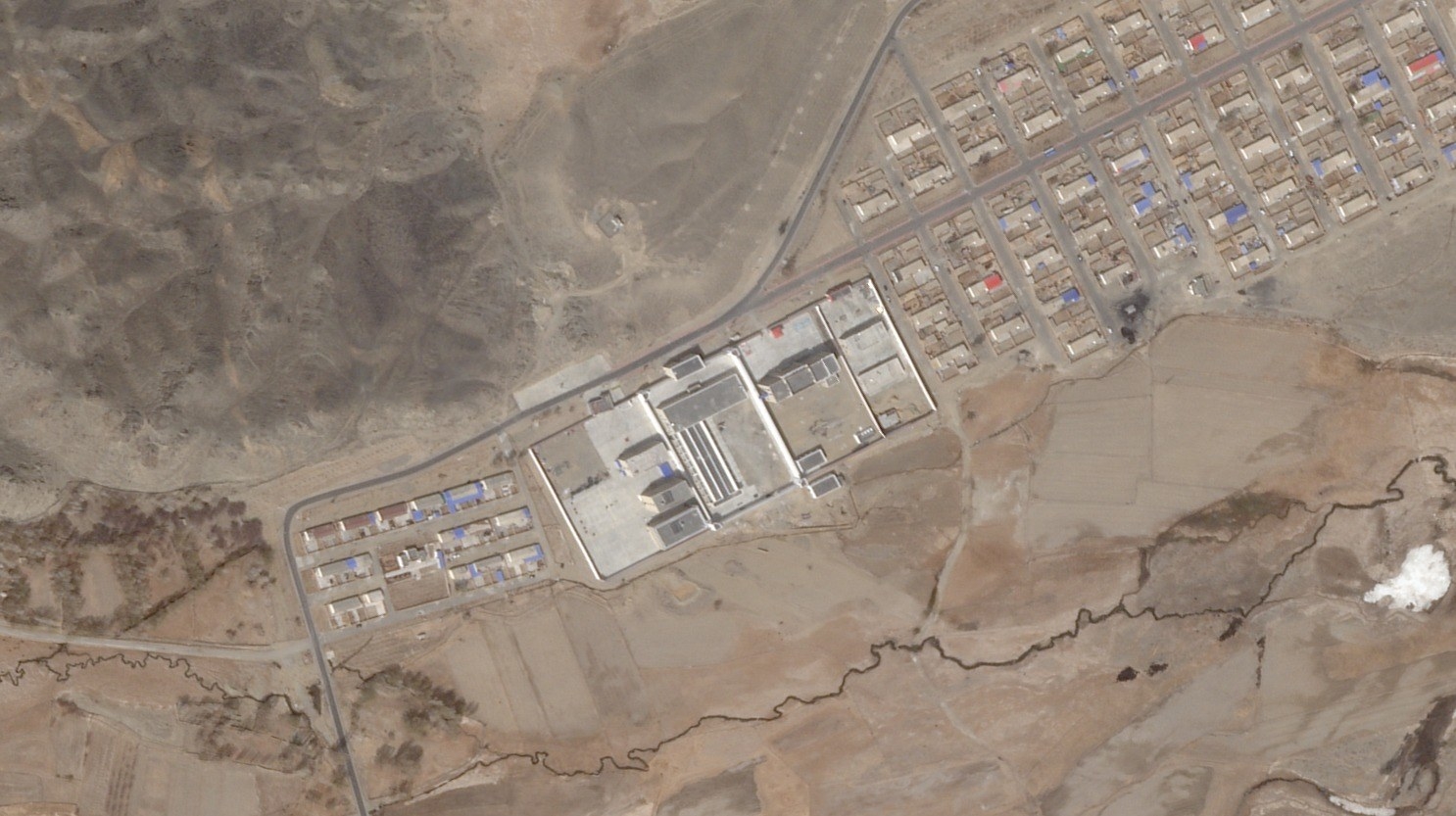
Read Part 1 of this investigation here. Read Part 2 here. For Part 3, click here. For Part 4, click here. For Part 5, click here.
This project was supported by the Open Technology Fund, the Pulitzer Center, and the Eyebeam Center for the Future of Journalism.
In the summer of 2018, as it became even harder for journalists to work effectively in Xinjiang, a far-western region of China, we started to look at how we could use satellite imagery to investigate the camps where Uighurs and other Muslim minorities were being detained. At the time we began, it was believed that there were around 1,200 camps in existence, while only several dozen had been found. We wanted to try to find the rest.
Our breakthrough came when we noticed that there was some sort of issue with satellite imagery tiles loading in the vicinity of one of the known camps while using the Chinese mapping platform Baidu Maps. The satellite imagery was old, but otherwise fine when zoomed out — but at a certain point, plain light gray tiles would appear over the camp location. They disappeared as you zoomed in further, while the satellite imagery was replaced by the standard gray reference tiles, which showed features such as building outlines and roads.
At that time, Baidu only had satellite imagery at medium resolution in most parts of Xinjiang, which would be replaced by their general reference map tiles when you zoomed in closer. That wasn’t what was happening here — these light gray tiles at the camp location were a different color than the reference map tiles and lacked any drawn information, such as roads. We also knew that this wasn’t a failure to load tiles, or information that was missing from the map. Usually when a map platform can’t display a tile, it serves a standard blank tile, which is watermarked. These blank tiles are also a darker color than the tiles we had noticed over the camps.
Once we found that we could replicate the blank tile phenomenon reliably, we started to look at other camps whose locations were already known to the public to see if we could observe the same thing happening there. Spoiler: We could. Of the six camps that we used in our feasibility study, five had blank tiles at their location at zoom level 18 in Baidu, appearing only at this zoom level and disappearing as you zoomed in further. One of the six camps didn’t have the blank tiles — a person who had visited the site in 2019 said it had closed, which could well have explained it. However, we later found that the blank tiles weren’t used in city centers, only toward the edge of cities and in more rural areas. (Baidu did not respond to repeated requests for comment.)
Having established that we could probably find internment camps in this way, we examined Baidu's satellite tiles for the whole of Xinjiang, including the blank masking tiles, which formed a separate layer on the map. We analyzed the masked locations by comparing them to up-to-date imagery from Google Earth, the European Space Agency’s Sentinel Hub, and Planet Labs.
In total there were 5 million masked tiles across Xinjiang. They seemed to cover any area of even the slightest strategic importance — military bases and training grounds, prisons, power plants, but also mines and some commercial and industrial facilities. There were far too many locations for us to sort through, so we narrowed it down by focusing on the areas around cities and towns and major roads.
Prisons and internment camps need to be near infrastructure — you need to get large amounts of building materials and heavy machinery there to build them, for starters. Chinese authorities would have also needed good roads and railways to bring newly detained people there by the thousand, as they did in the early months of the mass internment campaign. Analyzing locations near major infrastructure was therefore a good way to focus our initial search. This left us with around 50,000 locations to look at.
We began to sort through the mask tile locations systematically using a custom web tool that we built to support our investigation and help manage the data. We analyzed the whole of Kashgar prefecture, the Uighur heartland, which is in the south of Xinjiang, as well as parts of the neighboring prefecture, Kizilsu, in this way. After looking at 10,000 mask tile locations and identifying a number of facilities bearing the hallmarks of detention centers, prisons, and camps, we had a good idea of the range of designs of these facilities and also the sorts of locations in which they were likely to be found.
We quickly began to notice how large many of these places are — and how heavily securitized they appear to be, compared to the earlier known camps. In site layout, architecture, and security features, they bear greater resemblance to other prisons across China than to the converted schools and hospitals that formed the earlier camps in Xinjiang. The newer compounds are also built to last, in a way that the earlier conversions weren’t. The perimeter walls are made of thick concrete, for example, which takes much longer to build and perhaps later demolish, than the barbed wire fencing that characterizes the early camps.
In almost every county, we found buildings bearing the hallmarks of detention centers, plus new facilities with the characteristics of large, high-security camps and/or prisons. Typically, there would be an older detention center in the middle of the town, while on the outskirts there would be a new camp and prison, often in recently developed industrial areas. Where we hadn’t yet found these facilities in a given county, this pattern pushed us to keep on looking, especially in areas where there was no recent satellite imagery. Where there was no public high-resolution imagery, we used medium-resolution imagery from Planet Labs and Sentinel to locate likely sites. Planet was then kind enough to give us access to high-resolution imagery for these locations and to task a satellite to capture new imagery of some areas that hadn’t been photographed in high resolution since 2006. In one county, this allowed us to see that the detention center that had previously been identified by other researchers had been demolished and to find the new prison just out of town.
This is Yiwu, Hami prefecture in Google Earth, in the most recent publicly available high-resolution imagery. The photo was taken in 2006. The white marker shows the old, now-demolished prison and the red marker shows the new one on the outskirts.

Here is a close-up of the location where the new prison would eventually be built.

Planet Labs took a new satellite image in 2020, showing the fully built facility.

Prison requirements — why prisons are built where they are
There’s good reason why these places are developed close to towns. There’s the occasional camp in a more remote location, such as the sprawling internment camp in Dabancheng, but even there it’s next to a major road, with a small town nearby. Having the prison or camp close to an existing town minimizes, in principle, the distance that detainees must be transported (although there are also examples of prisoners and detainees being taken right across Xinjiang, from Kashgar to Korla, as in the drone video that reemerged recently, according to analysts). It is easier for families to visit loved ones who are in custody. Being near a town means that a prison or camp can be staffed more easily. Guards have families, their children need to go to school, their partners have jobs, they need access to healthcare, etc. Construction workers are needed to build the prison in the first place. It is also useful for amenities. Prisons and camps need electricity, water, telephone lines. It is way cheaper and easier to connect to an existing nearby network than to run new pipes and cables tens of kilometers to a more remote location.
Finally, you need a large plot of land for a prison, preferably with space to expand in the future, and this is what the recently developed industrial estates offer: large, serviced plots, close to existing towns and cities. Building in industrial estates also places the camps close to factories for forced labor. While many camps have factories within their compounds, in several cases that we know of detainees are bused to other factory sites to work.
Our list of sites
In total we identified 428 locations in Xinjiang bearing the hallmarks of prisons and detention centers. Many of these locations contain two to three detention facilities — a camp, pretrial administrative detention center, or prison. We intend to analyze these locations further and make our database more granular over the next few months.
Of these locations, we believe 315 are in use as part of the current internment program — 268 new camp or prison complexes, plus 47 pretrial administrative detention centers that have not been expanded over the past four years. We have witness testimony showing that these detention centers have frequently been used to detain people, who are often then moved on to other camps, and so we feel it is important to include them. Excluded from this 315 are 39 camps that we believe are probably closed and 11 that have closed — either they’ve been demolished or we have witness testimony that they are no longer in use. There are a further 14 locations identified by other researchers, but where our team has only been able to check the satellite evidence, which in these cases is weak. These 14 are not included in our list.
We have also located 63 prisons that we believe belong to earlier, pre-2016 programs. These facilities were typically built several years — in some cases, several decades — before the current internment program and have not been significantly extended since 2016. They are also different in style from the detention centers, known in Chinese as “kanshousuo,” and also from the newer camps. These facilities are not part of the 315 we believe to be in use as part of the current internment program and are included separately in our database.
Many of the earlier camps, which were converted from other uses, had their courtyard fencing, watchtowers, and other security features removed, often in late 2018 or early 2019. In some cases, the removal of most barricading, plus the fact that there are often cars parked in several places across the compounds, suggests that they’re no longer camps and are classified as probably closed in our database. The removal of the security features, in several cases, coincided with the opening of a larger, higher-security facility being completed nearby, suggesting that detainees may have been moved to the newer location.
Where facilities were purpose-built as camps and have had courtyard fencing removed but otherwise don’t show any change of use (like cars in the compound), we think they’re likely to still be camps — albeit with lower levels of security.
Acknowledgments
Our work has also built on the work of others, Shawn Zhang, Adrian Zenz, Bitter Winter, Gene Bunin, ETNAM, Open Street Map contributors, and the Laogai Handbook — we have sought to verify all of the locations in these databases (and attempted to locate the camps in the case of the Laogai Handbook), added them to our database where relevant, and classified them. The work of the Australian Strategic Policy Institute (ASPI), especially Nathan Ruser and his advice at an early stage of this project, was also invaluable. We would also like to note the contribution of the interpreters who worked with us. For security reasons, we aren’t sharing names or other identifying details, but would like nevertheless to publicly extend our thanks — you know who you are.
Alison Killing conducted this reporting with a grant and further assistance from the Open Technology Fund.


